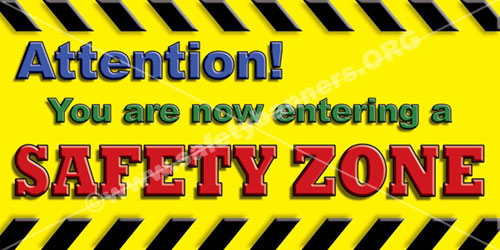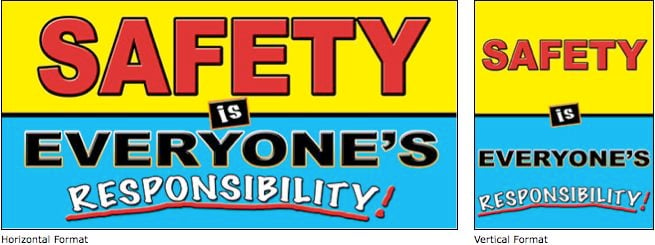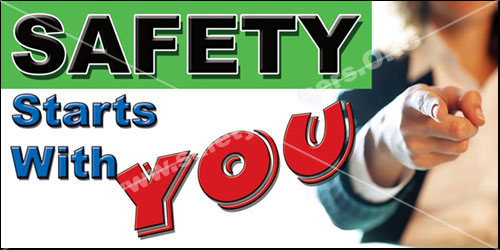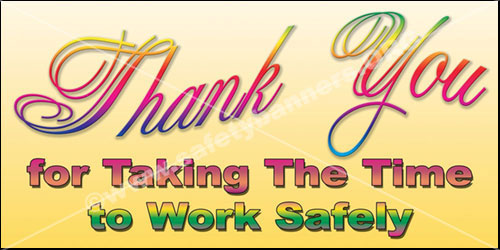Safety Banners in Both Horizontal & Vertical Format
CLICK HERE for our NEW safety store, Safety Banners USA (safetybannersUSA.com)
Only safety banners from SafetyBanners.Org come in both the horizontal and the vertical formats and 11 different sizes. Below is a sampling of what our two different safety banner formats look like together. No matter what your requirements, Safety Banners dot org can fill your need. We manufacture safety banners from 2 foot by 4 foot up to 10 feet by 20 feet and safety posters as small as 8 inches 16 inches. Safety Banners are our main business.

Safety Banners are our focus. Our safety zone safety banner is one of the most popular safety banners on our website. Our safety banners are high impact, high visibility and help improve safety awareness in your company. Check out our new innovative rack safety banners. They are safety banners designed specifically for your pallet rack ends. Look under the "Rack Banner" tab in our safety banners list. Innovation is how we became America's largest producer of industrial safety banners with slogans. Family Wants You Safe safety banners.
Our target zero accidents safety banner is also one of the most popular safety banners on our website. All of our safety banners are high impact, high visibility and help improve safety awareness in your company. Be sure to look at our new innovative rack safety banners. They are safety ban
ners designed specifically for your pallet rack ends. Look under the "Rack Banner" tab in our safety banners list. Innovation is how we became America's largest producer of industrial safety banners.
Live work play safely safety banners. All our safety banners are manufactured on demand and made of 100% industrial grade premium nylon reinforced vinyl. Our banners are 3 to 5 years outdoor fade resistant and and will last for over 30 years indoors.  We guarantee our safety banners, and all our safety products because we believe our customers are our most valuable asset. Our customers keep coming back for safety banners and safety posters over and over for a lot of reasons, but we believe the main reason is our great customer service.
We guarantee our safety banners, and all our safety products because we believe our customers are our most valuable asset. Our customers keep coming back for safety banners and safety posters over and over for a lot of reasons, but we believe the main reason is our great customer service.
 Safety Banners Help Protect Life And Property Safety and safety awareness cannot be ignored or underestimated. Safety banners play an important role in promoting safety and preventing accidents. Using safety banners at different places is an ideal way to bring various dangers or risks to the notice of employees. Safety Banners help avert disasters and help tackle emergency situations. The effective words printed on safety banners remind employees about the precautions they need to take at the workplace.
Safety Banners Help Protect Life And Property Safety and safety awareness cannot be ignored or underestimated. Safety banners play an important role in promoting safety and preventing accidents. Using safety banners at different places is an ideal way to bring various dangers or risks to the notice of employees. Safety Banners help avert disasters and help tackle emergency situations. The effective words printed on safety banners remind employees about the precautions they need to take at the workplace.
The messages displayed and communicated through these banners should be relevant to the workplace hazards, easy to understand, clearly presented and to the point. SafetyBanners.ORG is the foremost online safety banners store engaged in presenting an impeccable array of safety banners, team work banners and quality banners. The huge collection of safety banners offered by us includes Keep It Safe and Clean banners, No Accident Banners, Pay Attention to Safety, Wear Your Hard Hat, Avoid Accidents, Forklift Banners, Mirror Safety Message Signs and many others. All these banners are made using premium grade nylon reinforced vinyl and are offered at very low prices.
 All the safety banners provided by SafetyBanners.ORG are designed with precision and capture employee’s attention. Our colorful safety banners are digitally printed and add grace to the interiors and exteriors of every facility. The safety banners supplied by SafetyBanners.ORG have bright colored text printed in large fonts with color attractive images. These banners are highly effective in reinforcing safety policies in industrial America. We strive hard to bring forth fresh and innovative designs in safety banners to meet the varied needs of our clients. Also, our customers can personalize their banners or even design their own to meet their specific needs.
All the safety banners provided by SafetyBanners.ORG are designed with precision and capture employee’s attention. Our colorful safety banners are digitally printed and add grace to the interiors and exteriors of every facility. The safety banners supplied by SafetyBanners.ORG have bright colored text printed in large fonts with color attractive images. These banners are highly effective in reinforcing safety policies in industrial America. We strive hard to bring forth fresh and innovative designs in safety banners to meet the varied needs of our clients. Also, our customers can personalize their banners or even design their own to meet their specific needs.
When you need the greatest choice in Safety Banners, choose SafetyBanners.Org.
Safety Banners built in Memphis, Tennessee USA.
Our Safety Banners for Personal Protection Equipment / PPE are used by most of the Fortune 500 companies!
CLICK HERE for all our safety banners.
Safety Banners Starting at $68 in 12 Sizes Delivered in 3 days
<<< The product categories are on your left <<<
Safety Banners for Personal Protection Equipment (PPE) Use - Horizontal – Vertical – we do BOTH. SafetyBanners.Org is the ONLY safety banners manufacturer that offers PPE safety banners in BOTH Horizontal AND Vertical Format.
Personal protective equipment, commonly referred to as "PPE", is equipment worn to minimize exposure to serious workplace injuries and illnesses. These injuries and illnesses may result from contact with chemical, radiological, physical, electrical, mechanical, or other workplace hazards. Personal protective equipment may include items such as gloves, safety glasses and shoes, earplugs or muffs, hard hats, respirators, or coveralls, vests and full body suits.
All personal protective equipment should be of safe design and construction, and should be maintained in a clean and reliable fashion. It should fit well and be comfortable to wear, encouraging worker use. If the personal protective equipment does not fit properly, it can make the difference between being safely covered or dangerously exposed. When engineering, work practice, and administrative controls are not feasible or do not provide sufficient protection, employers must provide personal protective equipment to their workers and ensure its proper use. Employers are also required to train each worker required to use personal protective equipment to know:
If PPE is to be used, a PPE program should be implemented. This program should address the hazards present; the selection, maintenance, and use of PPE; the training of employees; and monitoring of the program to ensure its ongoing effectiveness.